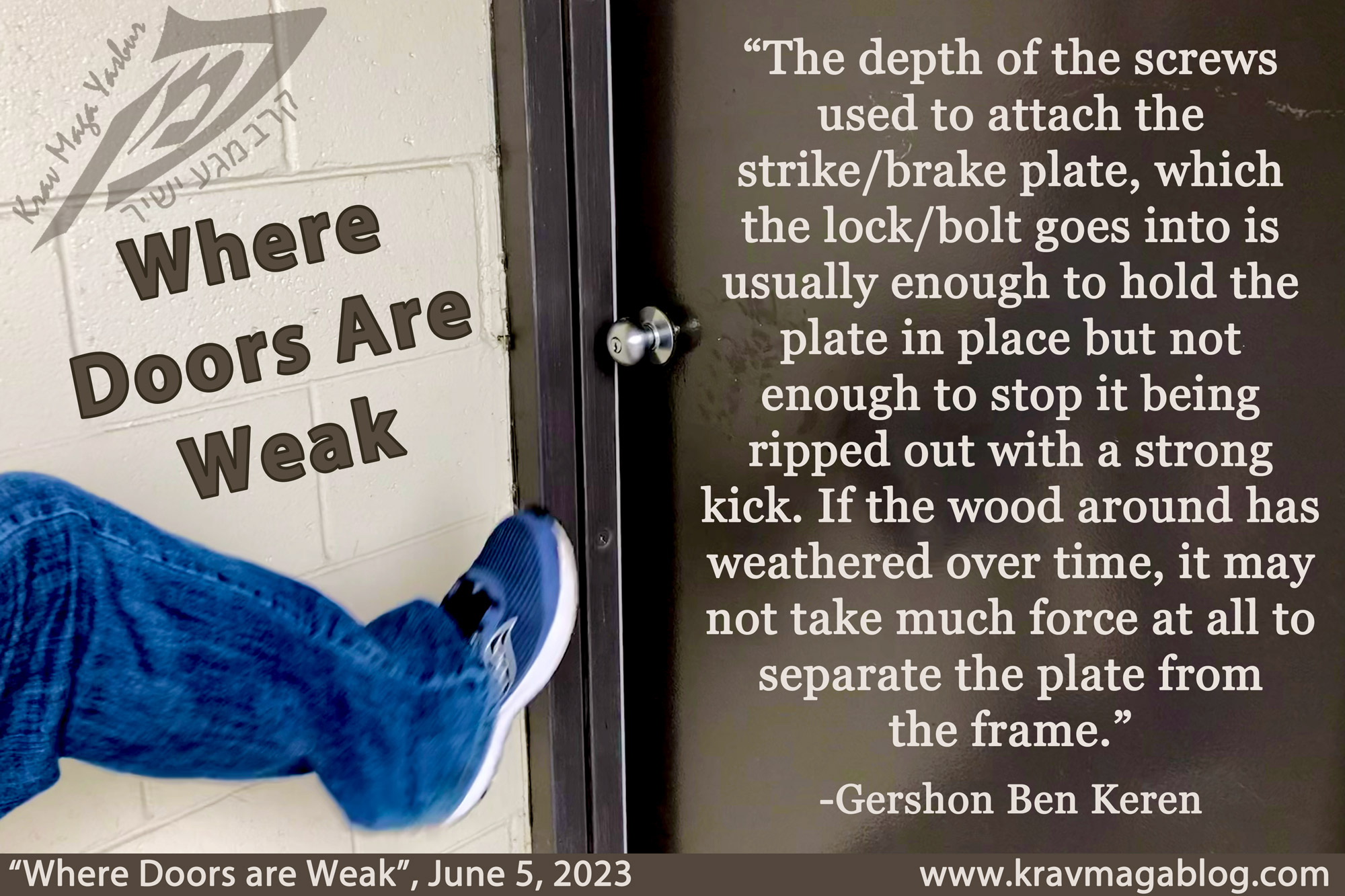Where Doors Are Weak, is an article written by Gershon Ben Keren, a 5th Degree Black Belt in Krav Maga, who teaches Krav Maga in Boston, MA. He has also authored three Amazon best-Selling Books on Krav Maga.
Debt collectors know how weak doors are. In certain jurisdictions if a door is open, it’s a legal invitation to enter a property and once inside, possessions can be removed, and the debt recovered; the value of the goods is determined by their auction value, which at best is usually a third of their actual worth. I could write several articles on why most debt that is bought isn’t “legal”, and the companies selling it don’t have a right to, however that is not the point of this article. Those who recover debt(s) know how easily a front door can be kicked in. I knew many recovery agents who would carry a wet foam dish cloth in a plastic bag, that would adhere to a door, and was used to disguise/mask the footprint of their shoe/boot when they gained “access” to a property. I often come across ads for lockpicking courses and products on social media as if these are the primary methods that people use to gain access to places they shouldn’t go etc. Whilst there may be some “academic” pleasure in learning how to pick a lock, most professionals whose job it is to legally test physical security i.e., get into places they shouldn’t be able to, will tell you that picking a lock is rarely the first option they test/try. Most doors, whilst seeming to be well-fitted, often have gaps and room that someone with experience can exploit, and these are usually the first vulnerabilities that anyone with experience will try to manipulate and utilize. However, this article is not about how to defeat a modern day “Raffles”, who is able to overcome any and every obstacle presented to them etc., as they attempt to break in, but rather how to implement a few simple steps, which will stop, or slow down, your “average” offender from being able to kick your door in.
Firstly, doors that open outwards are far harder to kick in than doors that open inwards. If your front door opens outwards, the frame that the door sits in offers a lot more integrity and is able to spread the force of a kick throughout the frame. However, this type of construction is often more common in commercial, as opposed to residential buildings/units etc. Whilst a door that opens inward may be a weakness, if it is accessed by steps e.g., you have to walk up a set of steps to reach it, then this may not be so much of a vulnerability. If someone wants to kick your door down, they need a platform which gives them the room to stand on and make their kick; steps don’t provide this. One thing that often gets forgotten about glass and wood is that they have a degree of elasticity. If you ever have to break a window (to get out of a building or car) don’t aim your striking tool/implement at the center of the glass, but rather at the edges. Modern glass used in automobiles and homes is extremely strong and elastic. Whilst wood may not appear to be so, when a panel is kicked it will spread the force. This is why anyone attempting to kick/knock a door in will focus their energy on the lock/handle i.e., they won’t try and actually kick the door down, they will attempt to smash the wood around the lock. In general, unless the wood is rotting around the hinges this is the single point of weakness. If I’m testing the integrity of a door, this is usually the first thing I look at. You would be surprised at the number of locked doors which will open or give, when you turn the handle and apply constant pressure by leaning on them. Ill-fitting locks, that have perhaps worn over time are a major/significant weakness in home defense.
Most locks/bolts are also not secured well. It should always be remembered that when homes are built/constructed it is usually to a “good enough” standard. I don’t mean this to disparage those who work in the construction industry. The usual spec that they are given is to install a lockable/securable door, rather than to make sure that it’s to a standard where someone can’t kick it down etc. This is why from a security perspective it is always good to give whatever asset you buy/acquire a look over from a security/safety perspective e.g., whenever I buy a new laptop – I’m a PC rather than Apple person – I take the time to update all the patches etc., and lock it down; As a kind of rule of thumb where security is concerned, with Apple you need to “open” things up, whereas Windows you need to close them down. The same is true of your home. Don’t assume that everything you’ve acquired is good enough as it may be you need to tighten things up. The depth of the screws used to attach the strike/brake plate, which the lock/bolt goes into is usually enough to hold the plate in place but not enough to stop it being ripped out with a strong kick. If the wood around has weathered over time, it may not take much force at all to separate the plate from the frame. In many cases – and it is worth taking a look – the plate may only be secured by four screws, with the plate itself being relatively small. A cheap DIY/Home Improvement project is to remove the existing plate and replace it with a much larger one, using longer screws. A plate that measures six to eight inches and can accommodate six to eight screws of a good depth (that go all the way into the door frame), is an inexpensive way to deal with this potential vulnerability.
As a kid who often forgot his front door key, I would look at the front door and think to myself, it’s just a thin piece of wood that’s preventing me from getting inside; and watching TV. Knowing now what I do about gaining access to places and how vulnerable that piece of wood, that is meant to stop me, is, I wonder why I ever felt that my house was a safe and impregnatable place it was. I’m glad for the ignorance/innocence of childhood.
0 COMMENTS















